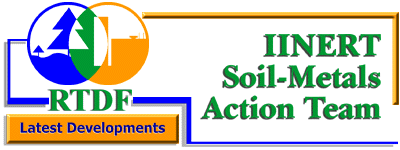 |
||||||||
 |
||||||||
![]()
![]()
|
IINERT Soil-Metals Action Team The In-Place Inactivation and Natural Ecological Restoration Technologies (IINERT) Soil-Metals Action Team was established in November 1995. It is one of the five current Action Teams under the Remediation Technologies Development Forum (RTDF). The RTDF was created by the U.S. Environmental Protection Agency (EPA) in 1992 to foster collaboration between the public and private sectors in developing innovative solutions to mutual hazardous waste problems. The IINERT Soil-Metals Action Team includes representatives from industry and government who share an interest in further developing and validating in situ techniques as viable technologies for eliminating the hazards of metals in soils and surficial materials.
IINERT technologies chemically and physically inactivate hazardous metals found in contaminated soils by reducing and essentially eliminating their solubility and bioavailability without the need for excavating the soil. In situ incorporation of chemicals such as phosphates, mineral fertilizers, iron oxyhydroxides, other minerals, biosolids, or limestone changes the molecular species of the metals. Changing a metal's molecular species may reduce its water solubility, bioavailability, and potential toxicity to humans and the environment. However, the total concentration of the metals may not necessarily change. The chemicals used for inactivation also may increase the fertility of the soil and eliminate any toxicities to plants and soil organisms. Growing a plant cover physically stabilizes the soil and its contaminants in place, which, in turn, minimizes soil erosion and the transport of soil-metals. Incorporating amendments and growing plants are more natural methods for restoring soil ecology compared to other techniques. Of the treatment options available for remediating metals-contaminated soils, in-place inactivation appears to be the most cost-effective. Additionally, it reduces the hazard posed by the contaminated soil in place. Since burying contaminated soil in a landfill or covering it over is not necessary, the potential for degradation and contamination of other areas is minimized.
The mission is to develop and demonstrate in-place inactivation and natural ecological restoration technologies that reduce and eliminate the risks to human health and the environment of metals/metalloids in soil and to achieve regulatory and public acceptance of these technologies.
What Are the Action Team's Goals The Action Team's Goals The goals of the Action Team are to:
The Action Team, in cooperation with the U.S. EPA, Missouri Department of Natural Resources (MDNR), University of Missouri, the U.S. Department of Agriculture-Agricultural Research Service (USDA-ARS), University of Colorado-Boulder, Exponent Environmental Services, The Doe Run Company, and the DuPont Company, initiated a field study at a site in Joplin, MO. The study is investigating how application of phosphorous (P) affects the bioavailability of lead (Pb) in the soil. Analysis of plants from the site have shown as high as an 80% reduction of Pb in the plant tops as a result of treatments, compared to untreated plots. In addition, immature pigs and weaning rats have been dosed with soils collected from the site to measure soil-Pb bioavailability. The dosing studies, conducted by the University of Missouri and USDA-ARS, have shown a significant reduction in Pb bioavailability in treated soils, compared to untreated soils.
Additional plant and soil samples, collected from the Joplin field site late in 1998, will be analyzed for total elemental concentrations in their tops. Both pigs and rats will be dosed with soils from selected treatments to determine changes in soil-Pb bioavailability. Several members of the IINERT Action Team will continue work, begun in 1998, on the ecological restoration of drastically disturbed areas throughout the country, a result of mining and smelting operations. Areas include land in Jasper County, MO, near Joplin; Pierce County, Washington; Coeur d'Alene River Basin, Idaho; and Leadville, Colorado. Biosolids, wood and fly ash, and other materials have been used or are being considered to help restore plant growth and productivity to the land. The Team also anticipates preparing a bibliography of IINERT-related publications which will be made available on the Team's home page on the RTDF World Wide Web site.
Would You Like More Information? For more information on the IINERT Soil-Metals Action Team, please contact the Team Co-chairs: Bill Berti, Ph.D. Jim Ryan, Ph.D.
|